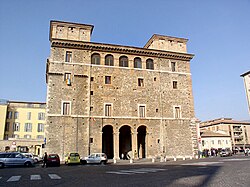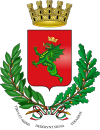Terni
Terni Interamna | |
|---|---|
| Comune di Terni | |
 Panorama o Terni | |
| Coordinates: 42°34′N 12°39′E / 42.567°N 12.650°E | |
| Kintra | Italy |
| Region | Umbrie |
| Province | Terni (TR) |
| Frazioni | Acquapalombo, Appecano, Battiferro, Cecalocco, Cesi, Collegiacone, Collescipoli, Collestatte, Giuncano Alto, Giuncano Scalo, Marmore, Miranda, Papigno, Piediluco, Poggio Lavarino, Polenaco, Porzano, Pracchia, Rocca San Zenone, San Carlo, San Liberatore, Titurano, Torreorsina |
| Govrenment | |
| • Mayor | Leopoldo Di Girolamo (Democratic Pairty) |
| Area | |
| • Total | 211 km2 (81 sq mi) |
| Elevation | 130 m (430 ft) |
| Population (30 November 2011) | |
| • Total | 113,444 |
| • Density | 540/km2 (1,400/sq mi) |
| Demonym(s) | Ternani |
| Time zone | UTC+1 (CET) |
| • Summer (DST) | UTC+2 (CEST) |
| Postal code | 05100 |
| Diallin code | 0744 |
| Patron saunt | Saunt Valentine |
| Saunt day | 14 Februar 14 |
| Website | Offeecial wabsteid |

Terni ![]() listen (help·info) (Laitin: Interamna) is a ceety in soothren Umbrie, central Italy, caipital o the province o Terni, locatit in the plain o the Nera river. It is 104 kilometre (65 mile) north o Roum, 36 kilometre (22 mile) northwast o Rieti, an 29 kilometre (18 mile) sooth o Spoleto.
listen (help·info) (Laitin: Interamna) is a ceety in soothren Umbrie, central Italy, caipital o the province o Terni, locatit in the plain o the Nera river. It is 104 kilometre (65 mile) north o Roum, 36 kilometre (22 mile) northwast o Rieti, an 29 kilometre (18 mile) sooth o Spoleto.
History
[eedit | eedit soorce]The ceety wis foondit aroond the 7t century BC bi the Umbries, in a territory inhabitit (as testifee'd bi archaeological excavations o several necropolises) as early as the Bronze Age. In the 3rd century BC it wis conquered bi the Romans an suin acome a important municipium leein on the Via Flaminia. The Roman name wis Interamna, meanin "in atween twa rivers". Durin the Roman Empire the ceety wis enriched wi several biggins, includin aqueducts, waws, amphitheatres, temples an brigs.
Efter the Lombard conquest (755) Terni lost ony role o prominence, reducin tae a seicontar toun in the Duchy o Spoleto. In 1174 it wis sackit bi Frederick Barbarossa's general, Airchbishop Christian o Mainz. In the follaein century Terni wis ane o the favourite seat o St. Francis' prayins.
In the 14t century Terni issued a constitution o its awn an frae 1353 the waws wur enlairgit, an new channels wur opened. As well as hintle the Italian communes o the Late Middle Ages, it wis slain bi inner disputes atween Guelphs an Ghibellines, an later atween the twa pairties o Nobili an Banderari. Later it acome pairt o the Papal States. In 1580 a airnwirk, the Ferriera, wis introducit tae wirk the airn ore mined in Monteleone di Spoleto, stairtin the tradeetional industrial connotation o the ceety. In the 17t century, housomeivver, Terni declined further due tae plagues an famines.
In the 19t century Terni teuk advantage o the Industrial Revolution an o plentiful watter soorces in the aurie. New industries includit a steelwirk, a foondry, as well as wappens, jute an oo factories. In 1927 Terni became caipital o the province. The presence o important industries made it a favourite target for the Alleed bombardments in Warld War II, totallin 108 raids. Despite this, industrial environs increased quickly, in fact the ceety is cried "the italian Manchester".
Economy
[eedit | eedit soorce]The ceety haes three important industrial hubs: the first ane is the Stainless cried AST (pairt o the group ThyssenKrupp) an is a wide aurie locatit in the east pairt o Terni. In the wastren pairt thare is a seicont industrial hub, kent as "aurie Polymer", wi fower different chemical multinaitional industries. The third industrial hub is the "TERNI Research", which produces technologies employed for green energies an constructs green pouer plants in Italy.
Transport
[eedit | eedit soorce]Terni is connectit wi the A1 motorwey, the Naitional Road Tiberina an Naitional Road Flaminia bi the RATO, a motorwey junction.
Terni railway station is pairt o the Ancona–Orte railwey, an is a junction station for twa seicondar lines an aw, the Terni–Sulmona railwey (which links Terni wi L'Aquila) an the Terni–Sansepolcro railwey (FCU) (which serves Perugia).
Main sichts
[eedit | eedit soorce]- The Roman amphitheatre, ance capable o 10,000 spectators, biggit in 32 BC.
- The smaw Roman gate o Porta Sant'Angelo, ane o the fower auncient entrances tae the ceety, hintle restored.
- Terni Cathedral (Duomo, Cattedrale di Santa Maria Assunta) (17t century). Built ower ane o the maist auncient Christian edifices o the ceety, it haes the day Baroque lines. In the interior is ane organ designed bi Gian Lorenzo Bernini. The belfry is frae the 18t century. The façade haes twa mediaeval gates: ane o thaim haes the profile o a sabot ance uised tae measur the ceetizen's shoes in order tae ensur that thay did no exceed a fixed leemit o decency.
- Kirk o S. Francesco.
- The Basilica o S. Valentino.
- Palazzo Mazzancolli is ane o the few remains o the Middle Ages past o the ceety.
- Palazzo Gazzoli (18t century), hoosin the Ceety's Gallery wi wirks bi Pierfrancesco d'Amelia, Benozzo Gozzoli, Gerolamo Troppa an Orneore Metelli.
- Palazzo Spada (16t century), bi Antonio da Sangallo the Younger. It is the current Toun Haw.
- The Lancia di Luce ("Lance o Licht"), bi the sculptor Arnaldo Pomodoro.
- The Romanesque kirks:
- S. Alò (11t century).
- S. Martino.
- S. Salvatore.
- Todi Castle (1100 AD) ance uised for wars is nou a vacation spot for tourists.
Nearbi, at the confluence o the Velino an Nera Rivers, is the Cascata delle Marmore, a 165 m watterfaw.
Internaitional relations
[eedit | eedit soorce]Twin touns — Sister ceeties
[eedit | eedit soorce]Freemit airtins
[eedit | eedit soorce]| Wikimedia Commons haes media relatit tae Terni. |
- Offeecial wabsteid
- AboutTerni.com Archived 2005-03-28 at the Wayback Machine
- Terni ceety portal
- Terni Oggi
- Terni at UmbriaTravel.Com Archived 2015-03-01 at the Wayback Machine


